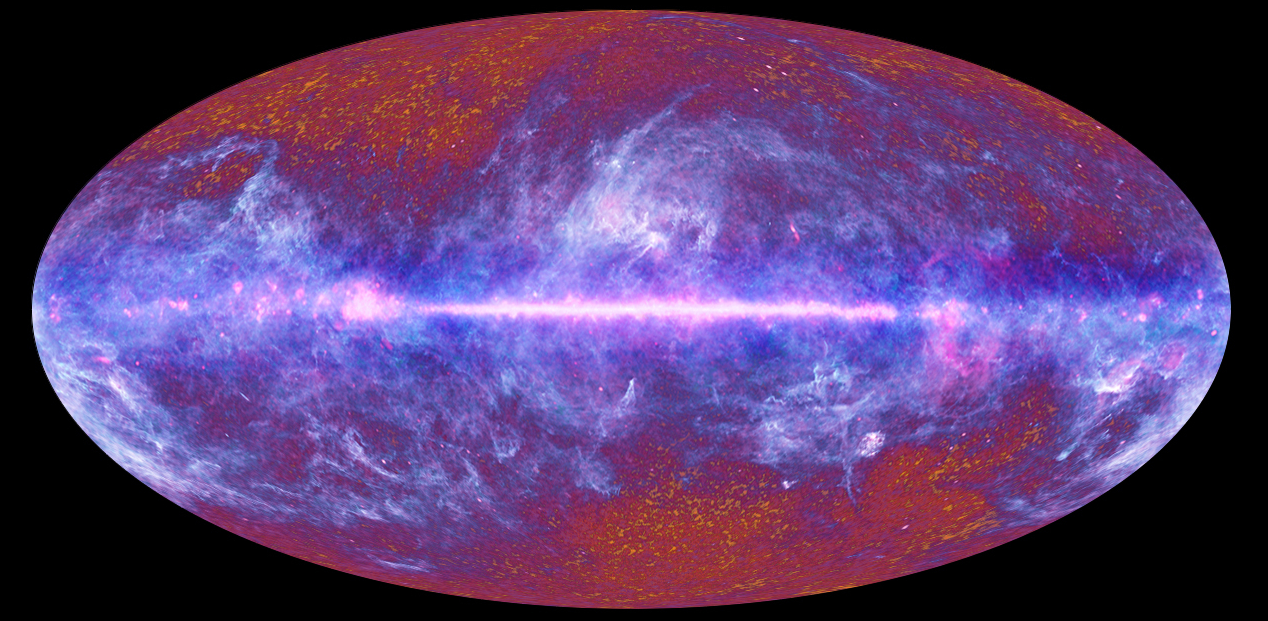The Universe Might Be a Giant Loop
What shape is space?

Everything we think we know about the shape of the universe could be wrong. Instead of being flat like a bedsheet, our universe may be curved, like a massive, inflated balloon, according to a new study.
That's the upshot of a new paper published today (Nov. 4) in the journal Nature Astronomy, which looks at data from the cosmic microwave background (CMB), the faint echo of the Big Bang. But not everyone is convinced; the new findings, based on data released in 2018, contradict both years of conventional wisdom and another recent study based on that same CMB data set.
Related: From Big Bang to Present: Snapshots of Our Universe Through Time
If the universe is curved, according to the new paper, it curves gently. That slow bending isn't important for moving around our lives, or solar system, or even our galaxy. But travel beyond all of that, outside our galactic neighborhood, far into the deep blackness, and eventually — moving in a straight line — you'll loop around and end up right back where you started. Cosmologists call this idea the "closed universe." It's been around for a while, but it doesn't fit with existing theories of how the universe works. So it's been largely rejected in favor of a "flat universe" that extends without boundary in every direction and doesn't loop around on itself. Now, an anomaly in data from the best-ever measurement of the CMB offers solid (but not absolutely conclusive) evidence that the universe is closed after all, according to the authors: University of Manchester cosmologist Eleonora Di Valentino, Sapienza University of Rome cosmologist Alessandro Melchiorri and Johns Hopkins University cosmologist Joseph Silk.
The difference between a closed and open universe is a bit like the difference between a stretched flat sheet and an inflated balloon, Melchiorri told Live Science. In either case, the whole thing is expanding. When the sheet expands, every point moves away from every other point in a straight line. When the balloon is inflated, every point on its surface gets farther away from every other point, but the balloon's curvature makes the geometry of that movement more complicated.
"This means, for example, that if you have two photons and they travel in parallel in a closed universe, they will [eventually] meet," Melchiorri said.
In an open, flat universe, the photons, left undisturbed, would travel along their parallel courses without ever interacting.
Get the world’s most fascinating discoveries delivered straight to your inbox.
The conventional model of the universe's inflation, Melchiorri said, suggests that the universe should be flat. Rewind the expansion of space all the way to the beginning, to the first 0.0000000000000000000000001 seconds after the Big Bang, according to that model, and you'll see a moment of incredible, exponential expansion as space grew out of that infinitesimal point in which it began. And the physics of that superfast expansion point to a flat universe. That's the first reason most experts believe the universe is flat, he said. If the universe isn't flat, you have to "fine-tune" the physics of that primordial mechanism to make it all fit together — and redo countless other calculations in the process, Melchiorri said.
But that might end up being necessary, the authors wrote in the new study.
That's because there's an anomaly in the CMB. The CMB is the oldest thing we see in the universe, made of ambient microwave light that suffuses all of space when you block out the stars and galaxies and other interference. It's one of the most important sources of data on the universe's history and behavior, because it's so old and so spread throughout space. And it turns out, according to the latest data, that there's significantly more "gravitational lensing" of the CMB than expected — meaning that gravity seems to be bending the microwaves of the CMB more than existing physics can explain.
The data the team is drawing upon comes from a 2018 release from the Planck experiment — a European Space Agency (ESA) experiment to map the CMB in more detail than ever before. (The new data will be published in a forthcoming issue of the journal Astronomy & Astrophysics and is available now on the ESA website. Both Di Valentino and Melchiorri were part of that effort as well.)
To explain that extra lensing, the Planck Collaboration has just tacked on an extra variable, which the scientists are calling "A_lens," to the group's model of the universe's formation, "This is something that you put there by hand, trying to explain what you see. There's no connection with physics," Melchiorri said, meaning there's no A_lens parameter in Einstein's theory of relativity. "What we found is that you can explain A_lens with a positively curved universe, which is a much more physical interpretation that you can explain with general relativity."
Melchiorri pointed out that his team's interpretation isn't conclusive. According to the group's calculations, the Planck data point to a closed universe with a standard deviation of 3.5 sigma (a statistical measurement that means about 99.8% confidence that the result isn't due to random chance). That's well short of the 5 sigma standard physicists usually look for before calling an idea confirmed.
But some cosmologists said there were even more reasons to be skeptical.
Andrei Linde, a cosmologist at Stanford University, told Live Science that the Nature Astronomy paper failed to take into account another important paper, published to the arXiv database on Oct. 1. (That paper has not yet been published in a peer reviewed journal.)
In that paper, University of Cambridge cosmologists George Efstathiou and Steven Gratton, who both also worked on the Planck Collaboration, looked at a narrower subset of data than the Nature Astronomy paper. Their analysis also supported a curving universe, but with much less statistical confidence than Di Valentino, Melchiorri and Silk found looking at a larger segment of the Planck data. However, when Efstathiou and Graton looked at the data together with two other existing data sets from the early universe, they found that overall, the evidence pointed toward a flat universe.
Asked about the Efstathiou and Gratton paper, Melchiorri praised the careful treatment of the work. But he said the duo's analysis relies on too small a segment of the Planck data. And he pointed out that their research is based on a modified (and, in theory, improved) version the Planck data — not the public data set that more than 600 physicists had vetted.
Linde pointed to that reanalysis as a sign that Efstathiou and Gratton's paper was based on better methods.
Efstathiou asked not to be directly quoted, but pointed out in an email to Live Science that if the universe were curved, it would raise a number of problems — contradicting those other data sets from the early universe and making discrepancies in the universe's observed rate of expansion much worse. Gratton said he agreed.
Melchiorri also agreed that the closed-universe model would raise a number of problems for physics.
"I don't want to say that I believe in a closed universe," he said. "I'm a little bit more neutral. I'd say, let's wait on the data and what the new data will say. What I believe is that there's a discrepancy now, that we have to be careful and try to find what is producing this discrepancy."
- 11 Fascinating Facts About Our Milky Way Galaxy
- Big Bang to Civilization: 10 Amazing Origin Events
- Spaced Out! 101 Astronomy Photos That Will Blow Your Mind
Originally published on Live Science.




